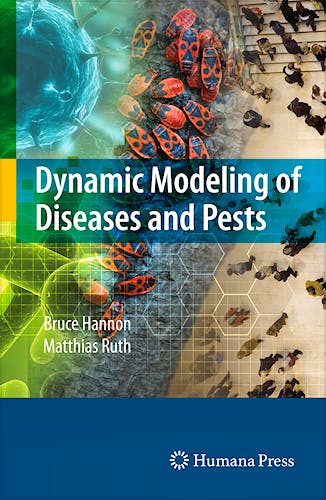

No hay productos en el carrito



Dynamic Modeling of Diseases and Pests
Hannon, B.
1ª Edición Diciembre 2008
Inglés
Tapa dura
290 pags
1500 gr
null x null x null cm
ISBN 9780387095592
Editorial SPRINGER
LIBRO IMPRESO
-5%
51,99 €49,39 €IVA incluido
49,99 €47,49 €IVA no incluido
Recíbelo en un plazo de
2 - 3 semanas
About this textbook
- Introduces students to hands-on dynamic modeling in the context of disease, and challenges them to use their models and insights to explore interventions that may help restrain contagion
- The structure is based on the assumption that modeling is best learned by doing and by then critically evaluating the structure, performance and outcome of the model
- Contains generic models of epidemics and chapters on individual diseases, as well as other forms of "pests" for which humanity has devised intervention and control mechanisms, based on the use of STELLA software
- Begins with simple models, focusing on the motivation and act of modeling as much as on the specific features of what is modeled, and gradually proceeds to the development of fairly complicated models
Models help us understand the nonlinear dynamics of real-world processes by using the computer to mimic the actual forces that result in a system’s behavior. The growing complexity of human social systems, from individual behavior to that of entire populations makes us increasingly vulnerable to diseases and pests. The ecology of the disease agents and the pests when considered in this social context only adds to the complexity. The feedbacks, lags in the effects of our preventive actions and the randomness in the environment make understanding of these vulnerabilities seem insurmountable. The amount and pace of modern travel provides virus and pest alike with the means to quickly find new hosts in untouched human populations and the ecosystems.
We thus have compelling reasons to understand the dynamics of these combined systems. This book begins with simple examples of human epidemics and then insect dynamics. Next comes the models of ever more complex models of disease carried by interaction of the two. An invasive species model is followed by insect-ecosystem interactions. The general models of chaos and catastrophe are linked to models of disease and pest. The final model is a spatial dynamic spread of disease among a wild animal population.
By using the STELLA programs (runtime versions and digital forms of all models are available with the book) we show how with a minimum of mathematical preparation and programming experience, these complex processes can be simulated and their emergent properties discovered. The programs run on both Macintosh and PC based machines.
Written for: Students and researchers in epidemiology, medicine, veterinary biosciences, animal and plant sciences, biochemistry, microbiology, public policy
Keywords:
- Contagious
- Disease management
- Infectious disease
- Pestilence
- Population biology
Table of contents
Part I: Introduction
1. The Why and How of Dynamic Modeling
1.1. Introduction
1.2. Static, Comparative-Static and Dynamic Models
1.3. Model Complexity and Explanatory Power
1.4. Model Components
1.5. Modeling in STELLA
1.6. Analogy and Creativity
1.7. STELLA’s Numeric Solution Techniques
1.8. Sources of Model Errors
1.9. The Detailed Modeling Process
1.10. Questions and Tasks
2. Basic Epidemic Models
2.1. Basic Model
2.2. Epidemic Model with Randomness
2.3. Loss of Immunity
2.4. Two Population Epidemic Model
2.5. Epidemic with Vaccination
2.6. Questions and Tasks
3. Insect Dynamics
3.1. Matching Experiments and Models of Insect Life Cycles
3.2. Optimal Insect Switching
3.3. Two-Age Class Parasite Model
3.4. Questions and Tasks
Part II: Applications
4. Malaria and Sickle Cell Anemia
4.1. Malaria
4.1.1. Basic Malaria Model
4.1.2. Questions and Tasks
4.2. Sickle Cell Anemia and Malaria in Balance
4.2.1. Sickle Cell Anemia
4.2.2. Questions and Tasks
5. Encephalitis
5.1. St. Louis Encephalitis
5.2. Questions and Tasks
6. Chagas Disease
6.1. Chagas Disease Spread and Control Strategies
6.2. Questions and Tasks
7. Lyme Disease
7.1. Lyme Disease Model
7.2. Questions and Tasks
8. Chicken Pox and Shingles
8.1. Model Assumptions and Structure
8.2. Questions and Tasks
9. Toxoplasmosis
9.1. Introduction
9.2. Model Construction
9.3. Results
9.4. Questions and Tasks
10. The Zebra Mussel
10.1. Introduction
10.2 Model Development
10.3 Model Results
10.4 Questions and Tasks
11. Biological Control of Pestilence
11.1. Herbivory and Algae
11.1.1. Herbivore-Algae Predator-Prey Model
11.1.2. Questions and Tasks
11.2. Bluegill Population Management
11.2.1. Bluegill Dynamics
11.2.2. Impacts of Fishing
11.2.3. Impacts of Disease
11.2.4. Questions and Tasks
11.3. Woolly Adelgid
11.3.1. Infestation of Fraser Fir
11.3.2. Adelgid and Fir Dynamics
11.3.3. Questions and Tasks
12. Indirect SIR Models of Arboviral Encephalitis Transmission
12.1. Emily Wheeler and Traci Barkley
12.2. Susceptible-Infected-Resistant (SIR) Models in Dynamic Populations
12.2.1. Model Structure and Behavior
12.2.2. Questions and Tasks
12.3. Base WNV SIR Model with a Dynamic Vector Population
12.3.1. Base Model Structure and Behavior
12.3.2. Questions and Tasks
12.4. Avian Population Effects and Seasonal Dynamics
12.4.1. Modifications to the Base Model
12.4.2. Avian Demography and Disease Persistence
12.4.3. Weather as an Extrinsic Driver of Outbreak Severity
12.4.4. Questions and Tasks
13. Chaos and Pestilence
13.1. Basic Disease Model with Chaos
13.1.1. Model Setup
13.1.2. Detecting and Interpreting Chaos
13.1.3. Questions and Tasks
13.2. Chaos with Nicholson-Bailey Equations
13.2.1. Host-Parasitoid Interactions
13.2.2. Questions and Tasks
14. Catastrophe and Pestilence
14.1. Basic Catastrophe Model
14.2. Spruce Budworm Catastrophe
14.3. Questions and Tasks
15. Spatial Dynamics of Pestilence
15.1. Diseased and Healthy Migrating Insects
15.1.1. Questions and Tasks
15.2. The Spatial Dynamic Spread of Rabies in Foxes
15.2.1. Introduction
15.2.2. Fox Rabies in Illinois
15.2.3. Previous Fox Rabies Models
15.2.4. The Rabies Virus
15.2.5. Fox Biology
15.2.6. Model Design
15.2.7. Cellular Model
15.2.8. Model Assumptions
15.2.9. Georeferencing the Modeling Process
15.2.10. Spatial Characteristics
15.2.11. Model Constraints
15.2.12. Model Results
15.2.13. Rabies Pressure
15.2.14. The Effects of Disease Alone
15.2.15. Hunting Pressure
15.2.16. Controlling the Disease
Part III: Conclusions
16. Conclusions
© 2026 Axón Librería S.L.
2.149.0